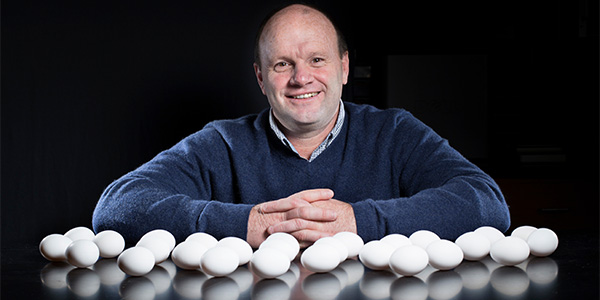
Keeping Tabs on the Economics of Eggs
Iowa egg producers started building on the state’s value during the late 1990s and by 2001, reclaimed the state’s past title as the number one egg-producing state in the nation.
Iowa has been the leader in egg production ever since, housing 49.3 million laying hens in 2016, producing an estimated 14 billion table eggs. According the United States Department of Agriculture, Iowa’s laying hen flock is nearly the size of the flocks located in Indiana and Ohio combined, the second and third largest respectively.
The individual who understands the industry’s past and can offer insight into its future is part of the team at the Egg Industry Center located at Iowa State University.
Maro Ibarburu (‘05 MS agricultural economics) works as the associate scientist and business analyst for the center. He didn’t grow up with a fascination for eggs or chickens, though they raised some on his family’s farm in Uruguay. He was drawn to Iowa State by the opportunity to learn and an interest and passion for economics. Ibarburu started his adventure under professor Brent Hueth and continued to work with others in agricultural economics.
“I expanded my knowledge of cattle production and marketing under John Lawrence, interim vice president for extension and outreach (then director of the Iowa Beef Center and professor of agricultural economics). I also learned a lot about pork production and marketing under James Kliebenstein, professor emeritus of economics. The education and support I got at Iowa State are priceless and will stay with me for the rest of my life,” says Ibarburu.
Ibarburu definitely has learned, so much so that following graduation he earned a position as a poultry economist. And, he is now the go-to person nationwide for three things: historical egg industry information, insight on the future of the flock and egg prices.
He continually analyzes data coming from the United States Department of Agriculture and other private sources to project what the future may hold for the industry. His efforts increase the accuracy of models used for reporting.
Forecasting markets is never an easy task, and it gets harder when the product doesn’t have a tight correlation between price and consumption.
“The correlation between egg price and egg consumption is weak. In only nine out of the last 17 years the consumption and the price moved in opposite directions, whereas in the remaining eight years, the consumption and the price moved in the same direction,” says Ibarburu.
The industry relies on the information he provides.
“The knowledge that Maro has, and the information that he generates is invaluable and critical to us as producers and to our industry partners because we have to make important investment decisions that have long-term impacts,” says Steve George, president and CEO of Fremont Farms of Iowa. “Maro is a key asset to the entire U.S. egg industry and we are lucky to have him in Iowa.”
To help Iowans better understand the impact of the Iowa egg industry, Ibarburu helped co-author an Iowa State University Extension and Outreach publication titled Economic importance of the Iowa Egg Industry. Updated periodically, this piece is used to help educate policy makers and others. Iowa Egg Council Executive Director Kevin Stiles says the publication has another use.
“Farmers use it when they meet with lenders and others when they look to grow or modify their farming or processing operations,” Stiles says. “It is one of our go-to pieces.”
Ibarburu also works as a collaborator on research projects and develops special reports on things like the market reaction to the High Pathogenic Avian Influenza outbreak in 2015, but ultimately he likes helping others the most.
“It is a fun job because sometimes I am helping a producer who has a question about the market reports, and other times I am helping a new allied industry person who is unfamiliar with egg production— like the one who started a job earlier this year for a company located in Des Moines,” he says.
The Iowa egg industry has an underlying network of supporting companies, and Ibarburu considers collaborating with these industry partners essential for the industry.
Besides some educational opportunities, Ibarburu also has helped one such company determine the egg industry’s capacity to sustain needed inputs for their operation. This information was used to determine if it was possible for them to locate within the state.
In response to industry needs and trends, he currently spends a considerable amount of time talking with those in the consumer food chain about the economic trade-offs of moving the industry to a cage-free production system.
“While we don’t know the future, we do know some of the trade-offs that exist,” says Ibarburu. “These include things like a bigger environmental footprint, increased disease pressure for the birds, and increased cost of production, which will increase prices on the grocery store shelf. One thing is certain, this industry is always changing and that means there is always something to learn.”



